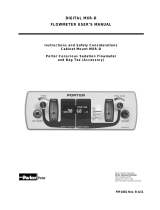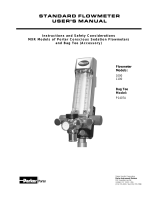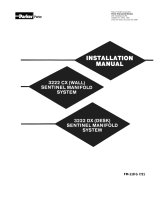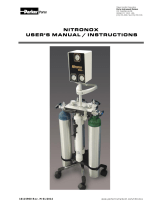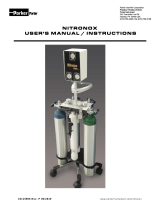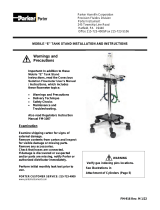Page is loading ...

FM-900 Rev. D 3/14
Compact Triple Cabinet Outlet Station Model 6258-1
Installation and Operating Instructions
The Porter Compact Triple Outlet Station (6258-1) provides a quick, safe, and reliable
method of connection to both Porter Sedation and Clean-Air™ outlet service in a
cabinet mount configuration. The 6258-1 provides all the service features of the Porter
6200-1 N2O/O2 outlet station, and the Porter 5600-3 Clean-Air outlet station. Features
include the cross+protection system to prevent unintentional misconnection to the
central piping system. A qualified plumber can install the outlet station by following the
details listed in this brochure.
WARNING
Porter Outlet Stations utilize the
cross+protection system. The flexible
hose and connectors used with the
Compact Triple Outlet to connect with
the central gas piping system are
diameter indexed. The
cross+protection system is designed
to prevent misconnection of Oxygen
and Nitrous Oxide piping. DO NOT
ATTEMPT TO CHANGE THE
DIAMETERS OR THE CONNECTION
CONFIGURATION OF THE
SEDATION COUPLERS TO THE
OUTLET STATION BLOCK!
Tampering with the cross+protection
system constitutes acceptance of
liability by the installer. For your own
protection, as well as that of the Doctor
and the patients, use 3/8” O.D. tubing
for all Nitrous Oxide lines and ½” O.D.
tubing for all Oxygen lines. The
vacuum line fitting into the outlet station
block is non-interchangeable with the
Oxygen fitting, but is field removable for
installation flexibility. The sedation
couplers are permanently attached to
the outlet station block.
To assure safe operation and
conformation to local fire codes, all
Porter Outlet Stations are designed to
be used with sedation delivery systems
mounted inside walls that meet or
exceed the guidelines established by
the National Fire Protection Association
for Nonflammable Medical Gas
Systems, NFPA 99. The Compact
Triple Outlet Station is designed to be
mounted INSIDE A CABINET ONLY,
AND AS SUCH, USES FLEXIBLE
HOSE. IF AN INSIDE WALL OR
WALL ATTACHMENT MOUNTING IS
REQUIRED, YOU MUST USE THE
STANDARD PORTER TRIPLE
OUTLET STATION. Copies of NFPA
99 or portions thereof may be obtained
by writing to:
National Fire Protection Association
Batterymarch Park
Quincy, MA 02269-9904
Or call: 1-800-344-3555

FM-900 Rev. D 3/14
WARNING
Dental workers are exposed to N2O during administration of N2O/O2 conscious
sedation analgesia. NIOSH has recommended that exposures should be minimized.
Contact NIOSH (1-800-35-NIOSH) to receive NIOSH Publications on Control of Nitrous
Oxide in Dental Operatories. Exposure can be minimized by effective controls.
National Institute for Occupational Safety and Health (NIOSH) publications state that
controls, including System Maintenance, Ventilation and Work Practices can effectively
reduce N2O concentrations in dental operations. Your Porter Scavenger System is an
important part of the system of controls.
STATION INSTALLATION INSTRUCTIONS
1. Select appropriate location inside
cabinet (not intended for wall
mounting), and secure the station
block using the factory set brackets
on both sides. Connections extend
upwards. The bottom of the block
must clear the bottom of the cabinet
by at least 1 ½ inches.
2. The station is designed to be used
with sedation lines that end in DISS
(Diameter Index Safety System)
couplers.
3. The sedation connections extending
upwards from the station block are
cross+protection system diameter
indexed and are permanently
attached to the block. DO NOT
REMOVE THE OXYGEN AND
NITROUS OXIDE NPT FITTINGS.
4. The vacuum connection to the
station block is tightened into a ¼”
NPT block hole. The vacuum line
fitting shipped with the station is non-
interchangeable with the Oxygen
sedation NPT block hole. For
installation flexibility, the vacuum line
fitting may be field removed and
replaced with another appropriate
fitting and line to attach to the HVE
High Volume Evacuation line.
5. After connecting all gas lines and the
flexible hoses to the sedation lines of
the station block, check the system
for leaks with oil free dry Nitrogen per
NFPA 99 Section 5.3.12.2.2.7.3
(static pressure test). This is a 60 PSI
test for pressure decay for 24 hours;
5 PSI drop allowed.
6. Check for crossed lines. (Refer to
NFPA Gas and Vacuum Systems
Code for Type lII Systems) (See
cross+protection Warning in this
brochure.)
7. Uncouple the sedation lines. Place
the plastic cover over the station
block, completely clearing the
mounting brackets and pressing
against the cabinet mounting
surface.
8. Alignment and Adjustment for Cover
and Front Plate Installation – The
Oxygen and Nitrous Oxide Valve
Bodies are factory adjusted to allow
for the plastic Cover to be captured
against the cabinet inside when the
Front Plate is attached with the six
(6), 4-40 flat head screws. The back
of the Front Plate should press
against the metal surfaces of all three
valve bodies. If adjustment is
needed, follow these steps:
8.1. Rotate the Oxygen and
Nitrous Oxide valve bodies so
they contact the back of the

3
Front Plate and achieve a
good tight capture of the
plastic Cover by the Front
Plate. Oxygen has right hand
threads and Nitrous Oxide has
left hand threads.
8.2. Adjust the right hand thread
vacuum valve body to align
with the metal surfaces of the
other valve bodies. Now back
it out ½ turn.
8.3. The two sedation valve bodies
should be in alignment and
touching the Front Plate
extruded holes, and the
vacuum valve body should be
slightly higher and should be
pressing against the flat part
of the Front Plate when it is
installed with the six flat head
screws.
9. Apply diameter indexed N2O/O2 gas
labels and vacuum label in place
over diameter indexed check valve
connector bushings. Pull off center
strip backing, and press label in
place. Remove top and bottom
backing strips, and finish securing
label.
10. Re-attach the sedation couplers and
flexible hose.
11. Connect an 8060 series duplex
connector and hoses into the
completely assembled Compact
Triple Outlet Station. Attach the
other end of the hoses to a flowmeter
and turn the flow control knobs to the
off position and the on/off switch to
the off position.
12. Leak test the entire system for
working pressure leaks.
Pressurize the sedation gas supply
lines with 50 PSI in a similar manner
as was done during the step 6, 50
PSI NFPA static pressure test.
Observe any pressure decay after 12
hours. This 50 PSI test with the
flowmeter tubing connections in
place tests the seal of the duplex
connector extended into the o-rings
of the outlet station primary check
valves. (5 PSI drop allowed.)
13. Attach the appropriate vacuum lines
to the station vacuum line.
CONNECTIONS TO FLOWMETER
OPERATING INSTRUCTIONS
Flowmeter Gas Supply Tubing and
Vacuum Tubing is connected to the
Compact Triple Outlet Station via two
quick connect couplers. The Porter
8060 series duplex connector
simultaneously connects the Oxygen
and Nitrous Oxide tubing, and prevents
the Nitrous Oxide from being connected
unless the Oxygen is connected. The
Porter 5602 vacuum quick connect with
hose barb separately inserts into the
vacuum check valve of the station.
Quick Connecting: You may quick
connect to the station when the system
pressure is at its normal 50 PSI; the
primary check valves seal this pressure.
Both couplers have locating latches.
Simply insert the couplers into the
appropriate check valve and confirm the
latch is in place behind the catch
feature of the valve. A gentle tug on the
coupler will confirm a stable latch
position. To remove, slide the latch out
of position.

4
Resuscitator: Remove the duplex
connector so a resuscitator quick
connect may be inserted into the
oxygen station position.
Upward position for 5602 right angle
vacuum quick connect hose barb:
Reconfigure the fitting using the
following steps if you need the barb to
point upwards.
Clip Reversal Instructions:
1. Note orientation of Clip on Assembly:
Hold assembly with Hose Barb in the
down position, and with the smooth
post facing you.
1.1. Note the position of the clip on
the assembly. This is
important, as you will need to
rotate the clip 180° from its
original position.
2. Remove the Crescent Ring using the
blade of a small flat blade
screwdriver.
3. Lift the clip from the assembly, and
as you do so, the spring will fall from
the clip.
4. Slide the clip back onto the assembly
in a position 180° from its original
location.
5. As the clip is brought down onto the
post, place the spring onto the pin
(located on the clip), and tuck the
opposite end into the pocket on the
adapter body.
6. Again using a flat bladed screwdriver,
push the Crescent Ring back into the
groove on the post. Orient the
Crescent Ring such that the opening
in the ring faces away from the
spring.
7. Actuate clip to ensure proper
operation of the assembly.
MAINTENANCE AND SERVICE
Use scavenging. Monitor for N2O in
the operatory to insure that controls are
effective in achieving low levels of ppm
(parts per million) exposure. Contact
your Porter dealer for details on
monitors and testing.
Inspect and maintain the analgesia
delivery system to prevent N2O leaks in
all hoses, connections and fittings.
Repair all leaks immediately.
MONTHLY CHECK: Leak test the
entire system for working pressure
leaks.
1. Connect an 8060 series duplex
connector and hoses into the
Compact Triple Outlet Station.
2. Attach the other end of the hoses to
a flowmeter and turn the flow control
knobs to the off position and the
on/off switch to the off position.
3. Pressurize the sedation gas supply
lines with 50 PSI, then close the gas
supply tank valves.
4. Observe any pressure decay after 12
hours. This 50 PSI test with the
flowmeter tubing connections in
place tests the seal of the duplex
connector extended into the o-rings
of the outlet station primary check
valves. (5 PSI drop allowed.)

5
Service Primary and Secondary
Check Valve Assemblies
The Oxygen and Nitrous Oxide primary
and secondary check valve assemblies
may be field disassembled and
replaced.
Service Primary Check Valve –
May be serviced with station
pressurized to 50 PSI.
1. Remove front plate. Mounting
screws are behind plate labels.
2. Unscrew the primary check valve
assembly. Oxygen right hand
threads; Nitrous Oxide left hand
threads. Note: the secondary
check valve will move into
position and seal the 50 PSI of the
station pressure as the primary
check valve assembly is removed.
WARNING
Do not remove the cartridge body
while servicing the primary check
valve assembly. The secondary
check valve cannot seal the 50 PSI
pressure if the cartridge body is
removed.
3. Replace the entire assembly.
4. Screw the replaced assembly into the
cartridge body.
5. Alignment and Adjustment for Cover
and Front Plate – Allow for the plastic
Cover to be captured against the
cabinet inside when the Front Plate is
attached with the six (6), 4-40 flat
head screws. The back of the Front
Plate should press against the metal
surfaces of all three valve bodies. If
adjustment is needed, follow these
steps:
5.1. Rotate the Oxygen and Nitrous
Oxide valve bodies so they
contact the back of the Front
Plate and achieve a good tight
capture of the plastic Cover by
the Front Plate. Oxygen has
right hand threads and Nitrous
Oxide has left hand threads.
5.2. Adjust the right hand thread
vacuum valve body to align with
the metal surfaces of the other
valve bodies. Now back it out ½
turn.
5.3. The two sedation valve bodies
should be in alignment and
touching the Front Plate
extruded holes, and the vacuum
valve body should be slightly
higher and should be pressing
against the flat part of the Front
Plate when it is installed with the
six flat head screws.
6. Leak test the entire system for
working pressure leaks per the
Monthly Check.
Service Secondary Check Valve
WARNING
To service the secondary check
valve, first turn off pressure. Do
not remove the cartridge body
until the pressure is bled off. The
secondary check valve cannot
seal the 50 PSI pressure if the
cartridge body is removed.
1. Turn off pressure at tanks in tank
room.

6
2. Follow procedure to remove primary
check valve assembly.
3. Depress secondary check valve
further into station block using a
small probe or screw driver to bleed
off pressure.
4. Unscrew cartridge body out of the
station block.
5. Take a small screw driver or needle
nose pliers and insert into holes at
the center of secondary check valve.
Carefully remove check valve and
spring.
6. Replace the 016 o-ring and
secondary check valve parts as
required and place in position for
reassembly.
7. Screw in the cartridge body and
tighten.
8. Screw in the primary check valve
assembly and align and adjust for
front plate installation.
9. Leak test the entire system for
working pressure leaks per the
Monthly Check.
CERTIFICATE OF WARRANTY
THIS WARRANTY IS GIVEN IN PLACE OF ALL OTHER WARRANTIES, EXPRESS OR
IMPLIED, OF MERCHANTABILITY, FITNESS FOR A PARTICULAR PURPOSE OR
OTHERWISE.
Under no circumstances shall Parker Hannifin Corporation be liable for incidental or consequential
damages as those terms are defined in the uniform commercial code.
Parker Hannifin Corporation, Porter Instrument Division warrants that each product or part shall be free
from defects in workmanship and materials, under normal use and with appropriate maintenance, for one
(1) year from the date of delivery to customer unless otherwise specified in writing. All rubber and plastic
parts and accessories are warranted under the same conditions for a period of ninety (90) days from
date of purchase.
No statement or claim about the product by any employee, agent, representative, or dealer of Parker
Hannifin Corporation shall constitute a warranty by Parker Hannifin Corporation or give to rise to any
liability or obligation of Parker Hannifin Corporation.
Parker Hannifin Corporation shall not be liable for any damage, injury or loss arising out of the use of the
product, whether as a result of a defect in the product or otherwise, if, prior to such damage, injury or
loss, the product was (1) damaged or misused; (2) repaired, altered or modified by persons other than
Parker Hannifin Corporation; (3) not installed in strict compliance with applicable codes and ordinances;
or (4) not installed by an authorized Parker Hannifin Corporation dealer. Parker Hannifin Corporation's
obligation for breach of this warranty, or for negligence or otherwise, shall be strictly and exclusively
limited to the repair or replacement of the product or part. This warranty shall be void on any product on
which the serial number has been altered, defaced or removed.
ORDERS All orders are to be made through authorized Parker Hannifin Corporation distributors. All
billing will be done through said distributors. Direct orders will be handled through the authorized local
dealer as determined by Parker Hannifin Corporation.
RETURNS No returns will be accepted unless authorized in writing by Porter Instrument Division, and
accompanied by a properly completed return goods authorization. All returns are subject to a re-stocking
and possible rework charges to be determined by Porter Instrument Division.
Policies subject to change without notice.
/


